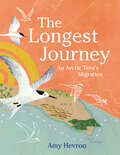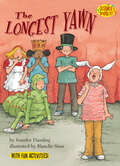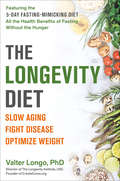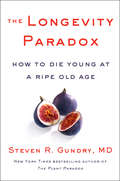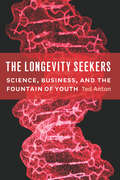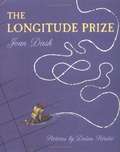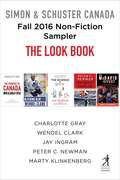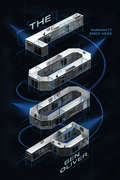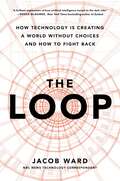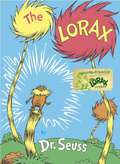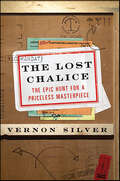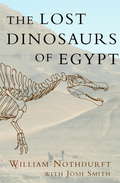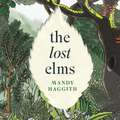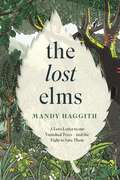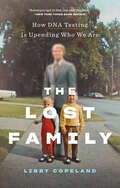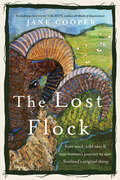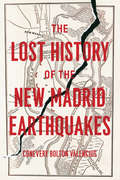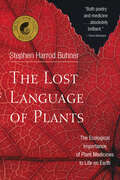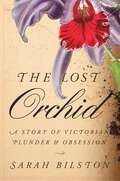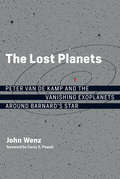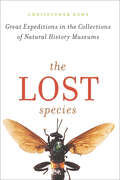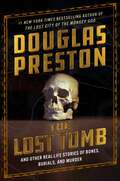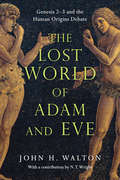- Table View
- List View
The Longest Journey: An Arctic Tern's Migration
by Amy HevronFollow the epic annual migration of an Arctic Tern on its sixty-thousand-mile journey to the South Pole and back again, the longest such migration in the animal kingdom. In their thirty-year lifetimes, Arctic Terns travel nearly 1.5 million miles, that&’s enough to fly to the Moon and back three times! Each year they brave blistering winds, storms, rough seas, and airborne predators as they travel between the Earth&’s poles, chasing the summer. In The Longest Journey: An Arctic Tern&’s Migration, we follow one such bird as it spreads its wings and sets out to make its first globe-spanning trip with its flock. Amy Hevron is the illustrator of Trevor by Jim Averbeck, the recipient of multiple starred reviews. She also illustrated Candace Fleming&’s The Tide Pool Waits which was the recipient of the Portfolio Honor Award from the Society of Children's Book Writers and Illustrators. Her brilliant, naturalistic artwork mimicking maps and nautical charts is supported by extensive research and paired with material at the back of the book explaining the science behind the life cycle of Arctic Terns. A Junior Library Guild Gold Standard Selection
The Longest Yawn (Science Solves It!)
by Jennifer DusslingSolve kid-sized dilemmas and mysteries with the Science Solves It! series. These fun books for kids ages 5–8 blend clever stories with real-life science. Why did the dog turn green? Can you control a hiccup? Is that a UFO? Find the answers to these questions and more as kid characters dive into physical, life, and earth sciences. Barry's teacher says that acting is mainly about control. But how can Barry control hiccups and yawns? Will he ever be a real actor? Books in this perfect STEM series will help kids think like scientists and get ahead in the classroom. Activities and experiments are included in every book! (Level Two; Science topic: Involuntary reflexes)
The Longevity Diet: Discover The New Science Behind Stem Cell Activation And Regeneration To Slow Aging, Fight Disease, And Optimize Weight
by Valter LongoThe internationally renowned, clinically tested, revolutionary diet program to lose weight, fight disease, and live a longer, healthier life. Can what you eat determine how long, and how well, you live? The clinically proven answer is yes, and The Longevity Diet is easier to follow than you'd think. The culmination of 25 years of research on aging, nutrition, and disease across the globe, this unique program lays out a simple solution to living to a healthy old age through nutrition. The key is combining the healthy everyday eating plan the book outlines, with the scientifically engineered fasting-mimicking diet, or FMD; the FMD, done just 3-4 times a year, does away with the misery and starvation most of us experience while fasting, allowing you to reap all the beneficial health effects of a restrictive diet, while avoiding negative stressors, like low energy and sleeplessness. Valter Longo, director of the Longevity Institute at USC and the Program on Longevity and Cancer at IFOM in Milan, designed the FMD after making a series of remarkable discoveries in mice, then in humans, indicating that specific diets can activate stem cells and promote regeneration and rejuvenation in multiple organs to significantly reduce risk for diabetes, cancer, Alzheimer’s, and heart disease. Longo’s simple pescatarian daily eating plan and the periodic fasting-mimicking techniques can both yield impressive results. Low in proteins and sugars and rich in healthy fats and plant-based foods, The Longevity Diet is proven to help you: • Lose weight and reduce abdominal fat • Extend your healthy lifespan with simple everyday changes • Prevent age-related muscle and bone loss • Build your resistance to diabetes, cardiovascular disease, Alzheimer's and cancer Longo’s healthy, life span-extending program is based on an easy-to-adopt pescatarian plan along with the fasting-mimicking diet no more than 4 times a year, just 5 days at a time. Including 30 easy recipes for an everyday diet based on Longo's five pillars of longevity, The Longevity Diet is the key to living a longer, healthier, more fulfilled life.
The Longevity Paradox: How to Die Young at a Ripe Old Age (The Plant Paradox #4)
by Dr. Steven R Gundry, MDFrom the author of the New York Times bestseller The Plant Paradox comes a groundbreaking plan for living a long, healthy, happy life.From the moment we are born, our cells begin to age. But aging does not have to mean decline. World-renowned surgeon Dr. Steven Gundry has been treating mature patients for most of his career. He knows that everyone thinks they want to live forever, until they hit middle age and witness the suffering of their parents and even their peers. So how do we solve the paradox of wanting to live to a ripe old age—but enjoy the benefits of youth?This groundbreaking book holds the answer. Working with thousands of patients, Dr. Gundry has discovered that the “diseases of aging” we most fear are not simply a function of age; rather, they are a byproduct of the way we have lived over the decades. In The Longevity Paradox, he maps out a new approach to aging well—one that is based on supporting the health of the “oldest” parts of us: the microorganisms that live within our bodies.Our gut bugs—the bacteria that make up the microbiome—largely determine our health over the years. From diseases like cancer and Alzheimer’s to common ailments like arthritis to our weight and the appearance of our skin, these bugs are in the driver’s seat, controlling our quality of life as we age.The good news is, it’s never too late to support these microbes and give them what they need to help them—and you—thrive. In The Longevity Paradox, Dr. Gundry outlines a nutrition and lifestyle plan to support gut health and live well for decades to come. A progressive take on the new science of aging, The Longevity Paradox offers an action plan to prevent and reverse disease as well as simple hacks to help anyone look and feel younger and more vital.
The Longevity Seekers: Science, Business, and the Fountain of Youth (From Obscurity, 1980-2005 -- Greater Than The Double Helix Itself, 1980-1990 -- The Grim Reaper, 1991-1993 -- Sorcerer's Apprentices, 1991-1996 -- Race For A Master Switch, 1989-2000 -- Money To Burn, 2000-2003 -- Longevity Noir, 2003-2004 -- Betting The Trifecta, 2005-2006 -- Defying Gravity: The Battle To Find A Drug For Extending Health, 2005-2013 -- Sex, Power And The Wild: The Evolution Of A)
by Ted Anton&“[A] beautifully told story of twenty-first-century researchers in pursuit of the secrets of longevity . . . a book both engaging and illuminating.&” —Deborah Blum, Pulitzer Prize-winning author People have searched for the fountain of youth everywhere from Bimini to St. Augustine. But for a steadfast group of scientists, the secret to a long life lies elsewhere: in the lowly lab worm. By suppressing the function of just a few key genes, these scientists were able to lengthen worms&’ lifespans up to tenfold, while also controlling the onset of many of the physical problems that beset old age. As the global population ages, the potential impact of this discovery on society is vast—as is the potential for profit. With The Longevity Seekers, science writer Ted Anton takes readers inside this tale that began with worms and branched out to snare innovative minds from California to Crete, investments from big biotech, and endorsements from TV personalities like Oprah and Dr. Oz. Some of the research was remarkable, such as the discovery of an enzyme in humans that stops cells from aging. And some—like an oft-cited study touting the compound resveratrol, found in red wine—proved highly controversial, igniting a science war over truth, credit, and potential profit. As the pace of discovery accelerated, so too did powerful personal rivalries and public fascination, driven by the hope that a longer, healthier life was right around the corner. Anton has spent years interviewing and working with the scientists at the frontier of longevity science, and this book offers a behind-the-scenes look at the state-of-the-art research and the impact it might have on global public health, society, and even our friends and family
The Longitude Prize
by Joan DashBy the start of the eighteenth century, many thousands of sailors had perished at sea because their captains had no way of knowing longitude, their east-west location. Latitude, the north-south position, was easy enough, but once out of sight of land not even the most experienced navigator had a sure method of fixing longitude. So the British Parliament offered a substantial monetary prize to whoever could invent a device to determine exact longitude at sea. Many of the world's greatest minds tried -- and failed -- to come up with a solution. Instead, it was a country clockmaker named John Harrison who would invent a clock that could survive wild seas and be used to calculate longitude accurately. But in an aristocratic society, the road to acceptance was not a smooth one, and even when Harrison produced not one but five elegant, seaworthy timekeepers, each an improvement on the one that preceded it, claiming the prize was another battle. Set in an exciting historical framework -- telling of shipwrecks and politics -- this is the story of one man's creative vision, his persistence against great odds, and his lifelong fight for recognition of a brilliant invention. <P> [This text is listed as an example that meets Common Core Standards in English language arts in grades 9-10 at http://www.corestandards.org.] <P> Winner of the Sibert Honor
The Look Book: Fall 2016 Non-Fiction Sampler
by Jay Ingram Charlotte Gray Wendel Clark Peter C Newman Marty KlinkenbergExploring bold new perspectives on our country, our athletic heroes, and the magic of the natural world, The Look Book offers a taste of nonfiction from across the Fall 2016 Simon & Schuster Canada list.Experience the sweeping history of Canada through its people and ideas, then discover the tales of those who found shelter here from the storm of revolution. Learn the bizarre and fascinating science behind every day phenomena, and answer more than a few age-old questions. Connect with two of hockey's greatest players: one who helped define the game today and one who's forging its future. With chapter excerpts from the following fall 2016 new releases: The McDavid Effect: Connor McDavid and the New Hope for Hockey, by Marty Klinkenberg The Promise of Canada: 150 Years--People and Ideas That Have Shaped Our Country, by Charlotte Gray Bleeding Blue: Giving My All for the Game, by Wendel Clark The Science of Why: Answers to Questions About the World Around Us, by Jay Ingram Hostages to Fortune: The United Empire Loyalists and the Making of Canada, by Peter C. Newman We hope you learn something extraordinary. The Team at Simon & Schuster Canada If you would like to learn more about any of our authors or the titles featured, please visit us at SimonandSchuster.ca, follow us on Twitter and Instagram at @simonschusterCA, or like us at Facebook.com/SimonandSchusterCanada.
The Loop (The Loop #1)
by Ben Oliver"A script-ready story with blockbuster potential." -- Kirkus (Starred Review)Life inside The Loop--the futuristic death row for teens under eighteen--is one long repetitive purgatory. But when news of the encroaching chaos in the outside world reaches the inmates and disorder begins to strike, the prison becomes the least of their worries. Perfect for fans of The Maze Runner and The Fifth Wave.It's Luka Kane's 16th birthday and he's been inside The Loop for over two years. Every inmate is serving a death sentence with the option to push back their execution date by six months if they opt into "Delays," scientific and medical experiments for the benefit of the elite in the outside world.But rumors of a war on the outside are spreading amongst the inmates, and before they know it, their tortuous routine becomes disrupted. The government-issued rain stops falling. Strange things are happening to the guards. And it's not long until the inmates are left alone inside the prison.Were the chains that shackled Luka to his cell the only instruments left to keep him safe? In a thrilling shift, he must overcome fellow prisoners hell-bent on killing him, the warden losing her mind, the rabid rats in the train tunnels, and a population turned into murderous monsters to try and break out of The Loop, save his family, and discover who is responsible for the chaos that has been inflicted upon the world.
The Loop: How Technology Is Creating a World Without Choices and How to Fight Back
by Jacob WardThis eye-opening narrative journey into the rapidly changing world of artificial intelligence reveals the dangerous ways AI is exploiting the unconscious habits of our minds, and the real threat it poses to humanity: "The best book I have ever read about AI" (New York Times bestselling author Roger McNamee). Artificial intelligence is going to change the world as we know it. But the real danger isn't some robot that's going to enslave us: It's our own brain. Our brains are constantly making decisions using shortcuts, biases, and hidden processes—and we're using those same techniques to create technology that makes choices for us. In The Loop, award-winning science journalist Jacob Ward reveals how we are poised to build all of our worst instincts into our AIs, creating a narrow loop where each generation has fewer, predetermined, and even dangerous choices. Taking us on a world tour of the ongoing, real-world experiment of artificial intelligence, The Loop illuminates the dangers of writing dangerous human habits into our machines. From a biometric surveillance state in India that tracks the movements of over a billion people, to a social media control system in China that punishes deviant friendships, to the risky multiple-choice simplicity of automated military action, Ward travels the world speaking with top experts confronting the perils of their research. Each stop reveals how the most obvious patterns in our behavior—patterns an algorithm will use to make decisions about what's best for us—are not the ones we want to perpetuate. Just as politics, marketing, and finance have all exploited the weaknesses of our human programming, artificial intelligence is poised to use the patterns of our lives to manipulate us. The Loop is call to look at ourselves more clearly—our most creative ideas, our most destructive impulses, the ways we help and hurt one another-so we can put only the best parts of ourselves into the thinking machines we create.
The Lorax
by Dr SeussLong before "going green" was mainstream, Dr. Seuss's Lorax spoke for the trees and warned of the dangers of disrespecting the environment. In this cautionary rhyming tale, we learn of the Once-ler, who came across a valley of Truffula Trees and Brown Bar-ba-loots, and how his harvesting of the tufted trees changed the landscape forever. With the release of the blockbuster film version, the Lorax and his classic tale have educated a new generation of young readers not only about the importance of seeing the beauty in the world around us, but also about our responsibility to protect it.
The Lorax
by Seuss<p>Celebrate nature with Dr. Seuss and the Lorax in this classic picture book about protecting the environment! <p><i>I am the Lorax. I speak for the trees.</i> <p>Dr. Seuss’s beloved story teaches kids to speak up and stand up for those who can’t. With a recycling-friendly “Go Green” message, The Lorax allows young readers to experience the beauty of the Truffula Trees and the danger of taking our earth for granted, all in a story that is timely, playful, and hopeful. The book’s final pages teach us that just one small seed, or one small child, can make a difference. </p>
The Lost Chalice: The Real-Life Chase for One of the World's Rarest Masterpieces—a Priceless 2,500-Year-Old Artifact Depicting the Fall of Troy
by Vernon Silver“A riveting story of tomb robbers and antiquities smugglers, high-stakes auctioneers and the princely chiefs of the world’s most prestigious museums….A terrific read, from start to finish.”—James L. Swanson, New York Times bestselling author of ManhuntAn Oxford-trained archaeologist and award-winning journalist based in Rome, Vernon Silver brings us The Lost Chalice, the electrifying true story of the race to secure a priceless, 2,500-year-old cup depicting the fall of Troy—a lost treasure crafted by Euphronios, an artist widely considered “the Leonardo Da Vinci of ancient Greece.” A gripping, real life mystery, The Lost Chalice gives readers a behind-the-scenes look at the inner workings of great museums and antiquities collections—exposing a world of greed, backstabbing, and double-dealing.
The Lost Dinosaurs of Egypt
by William Nothdurft Josh SmithThe date is January 11, 1911. A young German paleontologist, accompanied only by a guide, a cook, four camels, and a couple of camel drivers, reaches the lip of the vast Bahariya Depression after a long trek across the bleak plateau of the western desert of Egypt. The scientist, Ernst Freiherr Stromer von Reichenbach, hopes to find fossil evidence of early mammals. In this, he will be disappointed, for the rocks here will prove to be much older than he thinks. They are nearly a hundred million years old. Stromer is about to learn that he has walked into the age of the dinosaurs.At the bottom of the Bahariya Depression, Stromer will find the remains of four immense and entirely new dinosaurs, along with dozens of other unique specimens. But there will be reversals—shipments delayed for years by war, fossils shattered in transit, stunning personal and professional setbacks. Then, in a single cataclysmic night, all of his work will be destroyed and Ernst Stromer will slip into history and be forgotten.The date is January 11, 2000—eighty-nine years to the day after Stromer descended into Bahariya. Another young paleontologist, Ameri-can graduate student Josh Smith, has brought a team of fellow scientists to Egypt to find Stromer’s dinosaur graveyard and resurrect the German pioneer’s legacy. After weeks of digging, often under appalling conditions, they fail utterly at rediscovering any of Stromer’s dinosaur species.Then, just when they are about to declare defeat, Smith’s team discovers a dinosaur of such staggering immensity that it will stun the world of paleontology and make headlines around the globe.Masterfully weaving together history, science, and human drama, The Lost Dinosaurs of Egypt is the gripping account of not one but two of the twentieth century’s great expeditions of discovery.
The Lost Elms: The stunning new nature book from the 'unofficial poet laureate of our woodlands'
by Dr Mandy Haggith'Unofficial poet laureate of our woodlands.' - THE SCOTSMAN'Not just an elegy to our lost elms but also a meditation on life, culture and trees.' - FRED PEARCEFor millennia, elms shaped our landscape and our folklore; then they started dying.For the past century, a deadly pandemic has raged across the world, destroying all in its path and outmanoeuvring scientists' desperate attempts to halt it.Dutch elm disease has killed hundreds of millions of trees globally and over 25 million in the UK alone, altering our landscapes forever. Few young people have seen a mature elm tree, yet they once covered great swathes of Europe and North America and their legacy lives on in our mythology.The Lost Elms is a love letter to our vanished elms - the story of how we have nearly lost them all, and the long, slow fight back. It tells the gripping story of the scientists desperately trying to halt the disease's relentless progress, and demonstrates the deadly effect globalisation can have on the environment, the threat of climate change, the importance of biosecurity and the intricate ways in which trees are interlinked with other species. Woven throughout is a lyrical look at the elm's central place in our history, culture and folklore - the elm features heavily in Greek, Celtic, Japanese, Germanic and Scandinavian mythology; as the 'Liberty Tree' it played a symbolic role in both the American and French Revolutions; and since ancient times the elm has held associations with death and the supernatural.However all is not lost: recent breakthroughs in ecological understanding reveal elms to be far more resilient than we ever imagined. This tree holds an important place in our history, and now might just offer hopeful lessons for how we can save other disappearing species and our environment.
The Lost Elms: The stunning new nature book from the 'unofficial poet laureate of our woodlands'
by Dr Mandy Haggith'Unofficial poet laureate of our woodlands.' - THE SCOTSMAN'Not just an elegy to our lost elms but also a meditation on life, culture and trees.' - FRED PEARCEFor millennia, elms shaped our landscape and our folklore; then they started dying.For the past century, a deadly pandemic has raged across the world, destroying all in its path and outmanoeuvring scientists' desperate attempts to halt it.Dutch elm disease has killed hundreds of millions of trees globally and over 25 million in the UK alone, altering our landscapes forever. Few young people have seen a mature elm tree, yet they once covered great swathes of Europe and North America and their legacy lives on in our mythology.The Lost Elms is a love letter to our vanished elms - the story of how we have nearly lost them all, and the long, slow fight back. It tells the gripping story of the scientists desperately trying to halt the disease's relentless progress, and demonstrates the deadly effect globalisation can have on the environment, the threat of climate change, the importance of biosecurity and the intricate ways in which trees are interlinked with other species. Woven throughout is a lyrical look at the elm's central place in our history, culture and folklore - the elm features heavily in Greek, Celtic, Japanese, Germanic and Scandinavian mythology; as the 'Liberty Tree' it played a symbolic role in both the American and French Revolutions; and since ancient times the elm has held associations with death and the supernatural.However all is not lost: recent breakthroughs in ecological understanding reveal elms to be far more resilient than we ever imagined. This tree holds an important place in our history, and now might just offer hopeful lessons for how we can save other disappearing species and our environment.
The Lost Elms: The stunning new nature book from the 'unofficial poet laureate of our woodlands'
by Dr Mandy Haggith'Unofficial poet laureate of our woodlands.' - THE SCOTSMAN'Not just an elegy to our lost elms but also a meditation on life, culture and trees.' - FRED PEARCEFor millennia, elms shaped our landscape and our folklore; then they started dying.For the past century, a deadly pandemic has raged across the world, destroying all in its path and outmanoeuvring scientists' desperate attempts to halt it.Dutch elm disease has killed hundreds of millions of trees globally and over 25 million in the UK alone, altering our landscapes forever. Few young people have seen a mature elm tree, yet they once covered great swathes of Europe and North America and their legacy lives on in our mythology.The Lost Elms is a love letter to our vanished elms - the story of how we have nearly lost them all, and the long, slow fight back. It tells the gripping story of the scientists desperately trying to halt the disease's relentless progress, and demonstrates the deadly effect globalisation can have on the environment, the threat of climate change, the importance of biosecurity and the intricate ways in which trees are interlinked with other species. Woven throughout is a lyrical look at the elm's central place in our history, culture and folklore - the elm features heavily in Greek, Celtic, Japanese, Germanic and Scandinavian mythology; as the 'Liberty Tree' it played a symbolic role in both the American and French Revolutions; and since ancient times the elm has held associations with death and the supernatural.However all is not lost: recent breakthroughs in ecological understanding reveal elms to be far more resilient than we ever imagined. This tree holds an important place in our history, and now might just offer hopeful lessons for how we can save other disappearing species and our environment.
The Lost Family: How DNA Testing Is Upending Who We Are
by Libby Copeland“A fascinating exploration of the mysteries ignited by DNA genealogy testing—from the intensely personal and concrete to the existential and unsolvable.” —Tana French, New York Times–bestselling author You swab your cheek or spit in a vial, then send it away to a lab somewhere. Weeks later you get a report that might tell you where your ancestors came from or if you carry certain genetic risks. Or, the report could reveal a long-buried family secret that upends your entire sense of identity. Soon a lark becomes an obsession, a relentless drive to find answers to questions at the core of your being, like “Who am I?” and “Where did I come from?” Welcome to the age of home genetic testing.In The Lost Family, journalist Libby Copeland investigates what happens when we embark on a vast social experiment with little understanding of the ramifications. She explores the culture of genealogy buffs, the science of DNA, and the business of companies like Ancestry and 23andMe, all while tracing the story of one woman, her unusual results, and a relentless methodical drive for answers that becomes a thoroughly modern genetic detective story. Gripping and masterfully told, The Lost Family is a spectacular book on a big, timely subject.“An urgently necessary, powerful book that addresses one of the most complex social and bioethical issues of our time.” —Dani Shapiro, New York Times–bestselling author“Before you spit in that vial, read this book.” —The New York Times Book Review“Impeccably researched . . . up-to-the-minute science meets the philosophy of identity in a poignant, engaging debut.” —Kirkus Reviews (starred review)
The Lost Flock: Rare Wool, Wild Isles and One Woman’s Journey to Save Scotland’s Original Sheep
by Jane CooperThe Lost Flock is the story of the remarkable and rare little horned sheep, known as Orkney Boreray, and the wool-obsessed woman who moved to one of Scotland’s wildest islands to save them. It was Jane Cooper’s passion for knitting that led her to discover the world of rare-breed sheep and their wool. Through this, Jane uncovered the ‘Orkney Borerary’ – a unique group within the UK’s rarest breed of sheep, the Boreray, and one of the few surviving examples of primitive sheep in northern Europe. As her knowledge of this rarest of heritage breeds grew, she took the bold step to uproot her quiet suburban life in Newcastle and relocate to Orkney, embarking on a new adventure and life as farmer and shepherd. Jane was astonished to find that she was the sole custodian of this lost flock in the world, and so she began investigating their mysterious and ancient history, tracking down the origins of the Boreray breed and its significance to Scotland’s natural heritage. From Viking times to Highland crofts and nefarious research experiments in Edinburgh, this is a so-far untold real-life detective story. It is also the story of one woman’s relentless determination to ensure a future for her beloved sheep, and in doing so revealing their deep connection to the Scottish landscape. An unforgettable story of a heritage breed and the importance of its existence.
The Lost History of the New Madrid Earthquakes
by Conevery Bolton ValenciusFrom December 1811 to February 1812, massive earthquakes shook the middle Mississippi Valley, collapsing homes, snapping large trees midtrunk, and briefly but dramatically reversing the flow of the continent’s mightiest river. For decades, people puzzled over the causes of the quakes, but by the time the nation began to recover from the Civil War, the New Madrid earthquakes had been essentially forgotten. In The Lost History of the New Madrid Earthquakes, Conevery Bolton Valencius remembers this major environmental disaster, demonstrating how events that have been long forgotten, even denied and ridiculed as tall tales, were in fact enormously important at the time of their occurrence, and continue to affect us today. Valencius weaves together scientific and historical evidence to demonstrate the vast role the New Madrid earthquakes played in the United States in the early nineteenth century, shaping the settlement patterns of early western Cherokees and other Indians, heightening the credibility of Tecumseh and Tenskwatawa for their Indian League in the War of 1812, giving force to frontier religious revival, and spreading scientific inquiry. Moving into the present, Valencius explores the intertwined reasons—environmental, scientific, social, and economic—why something as consequential as major earthquakes can be lost from public knowledge, offering a cautionary tale in a world struggling to respond to global climate change amid widespread willful denial. Engagingly written and ambitiously researched—both in the scientific literature and the writings of the time—The Lost History of the New Madrid Earthquakes will be an important resource in environmental history, geology, and seismology, as well as history of science and medicine and early American and Native American history.
The Lost Language of Plants: The Ecological Importance of Plant Medicine to Life on Earth
by Stephen Harrod BuhnerNautilus Book Awards: Ecology/EnvironmentForeWord Reviews Book of the Year: Silver Medal, EnvironmentIn the &“pharmaceutical Silent Spring&” well-known author, teacher, lecturer, and herbalist Stephen Harrod Buhner has produced a book that is certain to generate controversy. Inside The Lost Language of Plants, you'll find:A critique of technological medicine, and especially the dangers to the environment posed by pharmaceuticals and other synthetic substances that people use in connection with health care and personal body care.A new look at Gaia Theory, including an explanation that plants are the original chemistries of Gaia and those phytochemistries are the fundamental communications network for the Earth&’s ecosystems.Extensive documentation of how plants communicate their healing qualities to humans and other animals. Western culture has obliterated most people&’s capacity to perceive these messages, but this book also contains valuable information on how we can restore our faculties of perception.The book will affect readers on rational and emotional planes. It is grounded in both a New Age spiritual sensibility and hard science. While some of the author&’s claims may strike traditional thinkers as outlandish, Buhner presents his arguments with such authority and documentation that the scientific underpinnings, however unconventional, are completely credible.The overall impact is a powerful, eye-opening exposé of the threat that our allopathic Western medical system, in combination with our unquestioning faith in science and technology, poses to the primary life-support systems of the planet. At a time when we are preoccupied with the terrorist attacks and the possibility of biological warfare, perhaps it is time to listen to the planet. This book is essential reading for anyone concerned about the state of the environment, the state of health care, and our cultural sanity.
The Lost Orchid: A Story of Victorian Plunder and Obsession
by Sarah BilstonThe forgotten story of a decades-long international quest for a rare and coveted orchid, chronicling the botanists, plant hunters, and collectors who relentlessly pursued it at great human and environmental cost.In 1818, a curious root arrived in a small English village, tucked—seemingly by accident—in a packing case mailed from Brazil. The amateur botanist who cultivated it soon realized that he had something remarkable on his hands: an exceptionally rare orchid never before seen on British shores. It arrived just as “orchid mania” was sweeping across Europe and North America, driving a vast plant trade that catered to wealthy private patrons as well as the fast-growing middle classes eager to display exotic flowers at home. Dubbed Cattleya labiata, the striking purple-and-crimson bloom quickly became one of the most coveted flowers on both continents.As tales of the flower’s beauty spread through scientific journals and the popular press, orchid dealers and enthusiasts initiated a massive search to recover it in its natural habitat. Sarah Bilston illuminates the story of this international quest, introducing the collectors and nurserymen who funded expeditions, the working-class plant hunters who set out to find the flower, the South American laborers and specialists with whom they contracted, the botanists who used the latest science to study orchids in all their varieties, and the writers and artists who established the near-mythic status of the “lost orchid.” The dark side of this global frenzy was the social and environmental harm it wrought, damaging fragile ecologies on which both humans and plants depended.Following the human ambitions and dramas that drove an international obsession, The Lost Orchid is a story of consumer desire, scientific curiosity, and the devastating power of colonial overreach.
The Lost Planets: Peter van de Kamp and the Vanishing Exoplanets around Barnard's Star (The\mit Press Ser.)
by John WenzA fascinating account of the pioneering astronomer who claimed (erroneously) to have discovered a planet outside the solar system.There are innumerable planets revolving around innumerable stars across our galaxy. Between 2009 and 2018, NASA's Kepler space telescope discovered thousands of them. But exoplanets—planets outside the solar system—appeared in science fiction before they appeared in telescopes. Astronomers in the early decades of the twentieth century spent entire careers searching for planets in other stellar systems. In The Lost Planets, John Wenz offers an account of the pioneering astronomer Peter van de Kamp, who was one of the first to claim discovery of exoplanets. Van de Kamp, working at Swarthmore College's observatory, announced in 1963 that he had identified a planet around Barnard's Star, the second-closest star system to the Sun. He cited the deviations in Barnard's star's path—“wobbles” that suggested a large object was lurching around the star. Van de Kamp became something of a celebrity (appearing on a television show with “Mr. Wizard,” Don Henry), but subsequent research did not support his claims. Wenz describes van de Kamp's stubborn refusal to accept that he was wrong, discusses the evidence found by other researchers, and explains recent advances in exoplanet detection, including transit, radial velocity, direct imaging, and microlensing. Van de Kamp retired from Swarthmore in 1972, and died in 1995 at 93. In 2009, Swarthmore named its new observatory the Peter van de Kamp Observatory. In the 1990s, astronomers discovered and confirmed the first planet outside our solar system. In 2018, an exoplanet was detected around Barnard's Star—not, however, the one van de Kamp thought he had discovered in 1963.
The Lost Species: Great Expeditions in the Collections of Natural History Museums
by Christopher KempThe tiny, lungless Thorius salamander from southern Mexico, thinner than a match and smaller than a quarter. The lushly white-coated Saki, an arboreal monkey from the Brazilian rainforests. The olinguito, a native of the Andes, which looks part mongoose, part teddy bear. These fantastic species are all new to science—at least newly named and identified; but they weren’t discovered in the wild, instead, they were unearthed in the drawers and cavernous basements of natural history museums. As Christopher Kemp reveals in The Lost Species, hiding in the cabinets and storage units of natural history museums is a treasure trove of discovery waiting to happen. With Kemp as our guide, we go spelunking into museum basements, dig through specimen trays, and inspect the drawers and jars of collections, scientific detectives on the hunt for new species. We discover king crabs from 1906, unidentified tarantulas, mislabeled Himalayan landsnails, an unknown rove beetle originally collected by Darwin, and an overlooked squeaker frog, among other curiosities. In each case, these specimens sat quietly for decades—sometimes longer than a century—within the collections of museums, before sharp-eyed scientists understood they were new. Each year, scientists continue to encounter new species in museum collections—a stark reminder that we have named only a fraction of the world’s biodiversity. Sadly, some specimens have waited so long to be named that they are gone from the wild before they were identified, victims of climate change and habitat loss. As Kemp shows, these stories showcase the enduring importance of these very collections. The Lost Species vividly tells these stories of discovery—from the latest information on each creature to the people who collected them and the scientists who finally realized what they had unearthed—and will inspire many a museumgoer to want to peek behind the closed doors and rummage through the archives.
The Lost Tomb: And Other Real-Life Stories of Bones, Burials, and Murder
by Douglas PrestonFrom the #1 bestselling author of The Lost City of the Monkey God, a jaw-dropping discovery of an Egyptian tomb opens up a slew of archaeological mysteries and deadly tales. Now in paperback with an EXCITING BONUS ADVENTURE! What&’s it like to be the first to enter an Egyptian burial chamber that&’s been sealed for thousands of years? What horrifying secret was found among the prehistoric ruins of the American Southwest? Who really was the infamous the Monster of Florence? From the jungles of Honduras to macabre archaeological sites in the American Southwest, Douglas Preston's explorations have taken him across the globe. The Lost Tomb brings together a compelling collection of true stories about buried treasure, enigmatic murders, lost tombs, bizarre crimes, and other fascinating tales of the past and present.
The Lost World of Adam and Eve: Genesis 2-3 and the Human Origins Debate (The Lost World Series #Volume 1)
by John H. Walton2016 Christianity Today Biblical Studies Award of Merit For centuries the story of Adam and Eve has resonated richly through the corridors of art, literature and theology. But for most moderns, taking it at face value is incongruous. And even for many thinking Christians today who want to take seriously the authority of Scripture, insisting on a "literal" understanding of Genesis 2–3 looks painfully like a "tear here" strip between faith and science. How can Christians of good faith move forward? Who were the historical Adam and Eve? What if we've been reading Genesis—and its claims regarding material origins—wrong? In what cultural context was this couple, this garden, this tree, this serpent portrayed? Following his groundbreaking Lost World of Genesis One, John Walton explores the ancient Near Eastern context of Genesis 2–3, creating space for a faithful reading of Scripture along with full engagement with science for a new way forward in the human origins debate. As a bonus, an illuminating excursus by N. T. Wright places Adam in the implied narrative of Paul's theology. The Lost World of Adam and Eve will be required reading for anyone seeking to understand this foundational text historically and theologically, and wondering how to view it alongside contemporary understandings of human origins.
